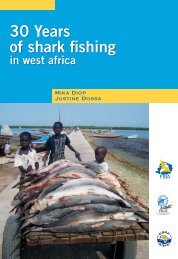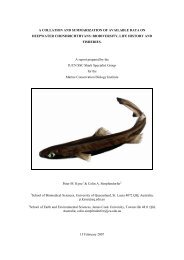Magazine of the species survival Commission specialist Group - IUCN
Magazine of the species survival Commission specialist Group - IUCN
Magazine of the species survival Commission specialist Group - IUCN
Create successful ePaper yourself
Turn your PDF publications into a flip-book with our unique Google optimized e-Paper software.
Editorial<br />
Message from <strong>the</strong> SSC Chair and<br />
<strong>the</strong> Head <strong>of</strong> <strong>the</strong> <strong>IUCN</strong> Species<br />
Programme<br />
We are writing this Message in late September 2010. Over<br />
<strong>the</strong> last several months, both <strong>of</strong> us have been very busy<br />
working on <strong>the</strong> preparations for <strong>the</strong> 10th Meeting <strong>of</strong> <strong>the</strong><br />
Conference <strong>of</strong> <strong>the</strong> Parties to <strong>the</strong> Convention on Biological<br />
Diversity (CBD), taking place in Nagoya, Japan, on 18–29<br />
October 2010. By <strong>the</strong> time you read this, <strong>the</strong> outcome <strong>of</strong> <strong>the</strong><br />
Nagoya meeting will be known. It is hard to over-emphasise<br />
<strong>the</strong> importance <strong>of</strong> <strong>the</strong> negotiations that will take place,<br />
because <strong>the</strong>y will determine whe<strong>the</strong>r or not <strong>the</strong> world’s<br />
governments have signed up to an ambitious biodiversity<br />
agenda leading up to 2020. The draft CBD Strategic Plan for<br />
2011–2020 is supposed to be this agenda, and <strong>the</strong> text <strong>of</strong><br />
this will be subject to detailed discussions in Nagoya.<br />
As all SSC members know, biodiversity loss and <strong>species</strong><br />
extinctions are continuing at unprecedented rates. Urgent<br />
action is needed to ensure <strong>the</strong> resilience <strong>of</strong> nature and<br />
economies, and to avoid catastrophic tipping points.<br />
Recovering from such dramatic changes in biodiversity will<br />
be costly. The CBD Strategic Plan, if adopted, will provide a<br />
roadmap for biodiversity conservation in <strong>the</strong> next decades. If<br />
<strong>the</strong> Plan is not adopted, <strong>the</strong> world will have no agreed<br />
biodiversity targets, and <strong>the</strong> Nagoya outcomes will be<br />
broadly <strong>the</strong> same as those from <strong>the</strong> climate summit in<br />
Copenhagen last year: essentially a failure. It is imperative<br />
that this situation is avoided and that <strong>the</strong> remaining<br />
contentious issues are resolved by <strong>the</strong> negotiators.<br />
At <strong>the</strong> last round <strong>of</strong> CBD negotiations in Nairobi in May<br />
2010, significant progress was made. From <strong>the</strong> perspective<br />
<strong>of</strong> SSC members, Target 12 in <strong>the</strong> draft Strategic Plan is<br />
particularly <strong>of</strong> interest: “By 2020, <strong>the</strong> extinction and decline <strong>of</strong><br />
known threatened <strong>species</strong> has been prevented and<br />
improvement in <strong>the</strong> conservation status for at least 10% <strong>of</strong><br />
<strong>the</strong>m has been achieved.” There is still debate among <strong>the</strong><br />
governments on whe<strong>the</strong>r or not to include <strong>the</strong> words “for at<br />
least 10% <strong>of</strong> <strong>the</strong>m” in <strong>the</strong> text, but we are never<strong>the</strong>less<br />
encouraged that this target is included, especially as in <strong>the</strong><br />
early phases <strong>of</strong> <strong>the</strong> negotiations, <strong>the</strong>re were attempts to<br />
reduce <strong>the</strong> focus on <strong>species</strong> significantly. There are several<br />
o<strong>the</strong>r important targets in <strong>the</strong> draft CBD Strategic Plan <strong>of</strong><br />
interest to <strong>the</strong> SSC, including on habitat loss, over-harvesting,<br />
invasive <strong>species</strong>, coral reefs, protected areas, ecosystem<br />
services, climate change, and access to genetic resources,<br />
among o<strong>the</strong>rs, which in total represent pretty much all that<br />
needs to be done to eventually halt <strong>the</strong> loss <strong>of</strong> biodiversity.<br />
Despite <strong>the</strong> generally positive outcome, <strong>the</strong> Nairobi<br />
negotiations, success in Nagoya is not guaranteed. One <strong>of</strong><br />
<strong>the</strong> major points <strong>of</strong> contention, on which agreement needs<br />
Nepen<strong>the</strong>s sp. © Travlinman43<br />
to be reached in Nagoya, is a bold target for increasing <strong>the</strong><br />
financial resources available for biodiversity conservation<br />
through an effective resource mobilization strategy. When<br />
<strong>the</strong> draft Strategic Plan was discussed in Nairobi, <strong>the</strong><br />
European Union (EU) argued for a strong biodiversity<br />
mission to halt biodiversity loss by 2020. However, <strong>the</strong> EU<br />
was at that time unwilling to specify a numerical target for<br />
increased funding for conservation that would enable its<br />
proposed mission to be achieved. On <strong>the</strong> o<strong>the</strong>r hand, some<br />
developing countries called for a strong financial target to be<br />
supported by <strong>the</strong> EU and o<strong>the</strong>r developed countries before<br />
<strong>the</strong>y could agree on a mission calling for a halt to biodiversity<br />
loss by 2020. The fate <strong>of</strong> <strong>the</strong> Strategic Plan depends on <strong>the</strong><br />
unlocking <strong>of</strong> this deadlock.<br />
In our view, it is essential that <strong>the</strong> governments and o<strong>the</strong>r<br />
stakeholders have <strong>the</strong> means to achieve <strong>the</strong> CBD Strategic<br />
Plan, yet <strong>the</strong>re is a persistent and critical shortage <strong>of</strong> financial<br />
resources available. <strong>IUCN</strong> believes that it is both necessary<br />
and feasible to mobilize significant new funding for <strong>the</strong><br />
implementation <strong>of</strong> <strong>the</strong> Strategic Plan. As a provisional funding<br />
target for 2020, <strong>IUCN</strong> recommends a goal <strong>of</strong> USD 300 billion<br />
annually from all sources. This is equivalent to 100 times <strong>the</strong><br />
current level <strong>of</strong> biodiversity-related aid, as reported by <strong>the</strong><br />
Organization for Economic Cooperation and Development<br />
(OECD). <strong>IUCN</strong> believes that this target can be achieved, but<br />
only by using a variety <strong>of</strong> instruments and by mobilizing<br />
<strong>species</strong> 52 • 1
















